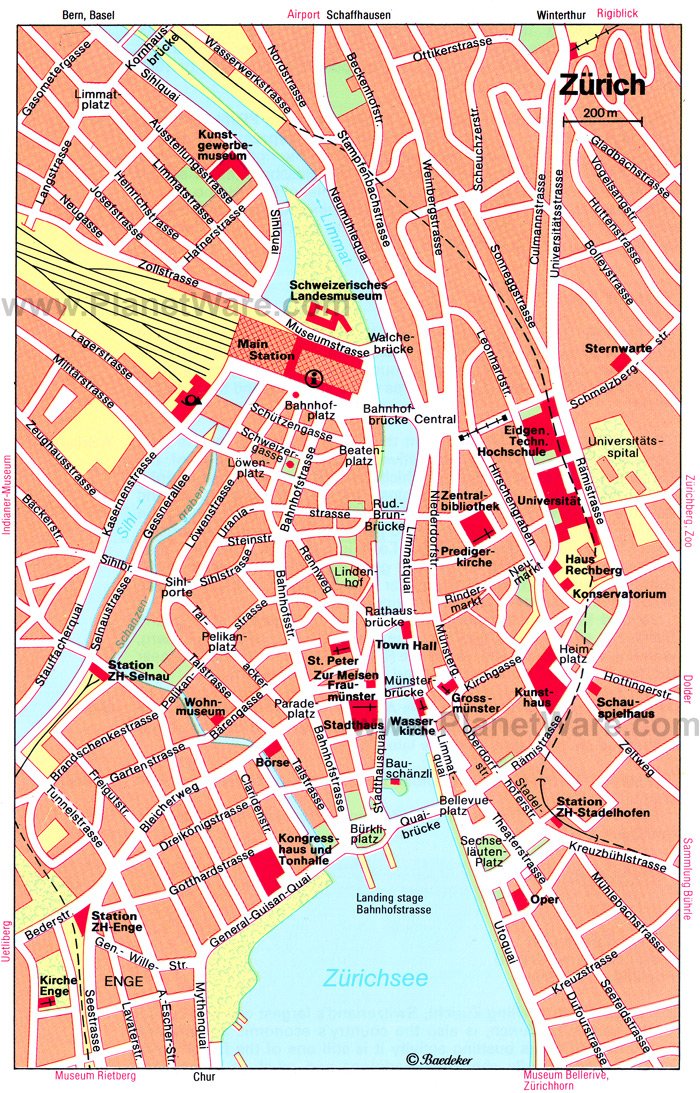I realize I've introduced you to quite a bit about life in Zurich, but I haven't yet informed you about the layout of the city. Zurich is a city which sits between two lower range mountains. Utliberg (not shown on the map), the mountain on the western side of the city has an eastern slope that is mostly wooded and a western slope that is covered in rolling hills used for pasturing cows. A train runs from the train station in Zurich most of the way up the mountain. The hiking path along the top provides spectacular views of Zurich and a few restaurants provide traditional Swiss fare to hungry hikers. Zurichberg Mountain runs along the eastern side of the city. It is wooded and has several hiking and mountain biking trails. Also, there are several spots where groups can gather and build outdoor fires. Our daughter's class has traveled often by tram and funnicular up Zurichberg Mountain. They've hiked, jumped off and around boulders and built fires on which to cook their lunches. Last weekend we hiked up the mountain to see where she has gone. What a great adventure they must have together!
This is a hiking trail along the top of Utliberg Mountain. Cows grazing along the western side of Utliberg Mountain. Often hikers can smell the cows before seeing them. Looking down on the lake and the southern end of Zurich with the Alps in the background


Hiking in the rain on one of the trails in the woods at the top of Zurichberg Mountain One of the campfire building sites on the top of Zurichberg Mountain

We live about a third of the way up Zurichberg Mountain just behind the Universitatspital, the University of Zurich Hospital. Take a look at the map and locate the major river, the Limmat, and the lake, Zurichsee. Much of what is happening in Zurich occurs right around these two bodies of water.
The lake, in particular, offers the possibility of a variety of recreational activites. It's banks are lined with large grassy areas for picnicing and playing and beautiful walking paths. In addition, people swim in the lake and river in the summer time. While there are designated areas for families and kids with docks, rental paddle boats, slides and even dressing rooms, people are permitted to jump in anywhere along the banks of the lake for a dip. Both the lake and river waters are clean. (It is difficult for me to get my mind around this as they are in the heart of a large city, but I have not seen evidence to suggest otherwise) As a matter of fact, the drinking water for the city comes from the lake. Boating is another favorite water activity in Zurich with a boathouse for sculling and sweep rowing and a few marinas for sailboats and motor boats. There is even a tram with several tram stops that runs up and down the river and lake.
Changing place for lake swimmers Walking path along the lake lawn for lounging and playing along the lake Water slide and designated kiddie swimming area on the lake



Besides the mountains and water, the city offers museums galore, a ritzy shopping district, a growing alternative area, and a medieval section.




The church to the right has the largest clock tower in all of Europe. The church to the left with the green steeple has Marc Chagall, stained glass windows. The area at the base of the churches is called Aldstadt or Old Town. It has cobble stone streets and old passageways between buildings. However, it is also the most expensive shopping district in Zurich. We’ve seen watches priced at 18,000 Swiss Francs in a shop window. There is a tradition of sweethearts "sealing their love” by securing padlocks to bridges in Europe. Several thousand locks are attached to one bridge in Zurich.











































































































